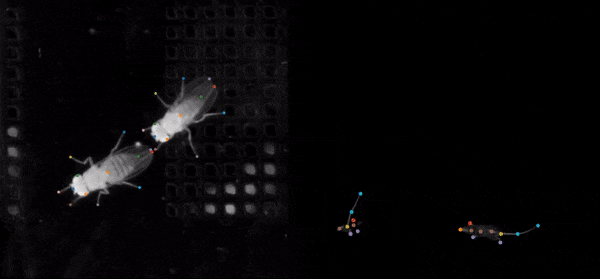SLEAP (Social LEAP Estimates Animal Poses) is a deep learning framework for animal pose tracking.
Project description
Features
Purpose-built GUI and human-in-the-loop workflow for rapidly labeling large datasets
Multi-animal pose estimation with top-down and bottom-up training strategies
State-of-the-art pretrained and customizable Neural Network architectures that deliver accurate predictions with very few labels
Fast training: 15 to 60 mins on a single GPU for a typical dataset
Fast inference: 400+ FPS for batch, 10ms latency for realtime
Support for remote training/inference workflow (for using without GPUs)
Flexible developer API for building integrated apps and customization
References
If you use SLEAP in your research, please cite:
Talmo D. Pereira, Nathaniel Tabris, Junyu Li, Shruthi Ravindranath, Eleni S. Papadoyannis, Z. Yan Wang, David M. Turner, et al. 2020. “SLEAP: Multi-Animal Pose Tracking.” bioRxiv. https://doi.org/10.1101/2020.08.31.276246.
License
SLEAP is released under a Clear BSD License and is intended for research/academic use only. For commercial use, please contact: Laurie Tzodikov (Assistant Director, Office of Technology Licensing), Princeton University, 609-258-7256.
Contact
Follow @MurthyLab on Twitter for news and updates!
Technical issue with the software? Open an issue on GitHub.
Press inquiries? Interested in using SLEAP in a commercial application? Reach out at sleap@princeton.edu.
Contributors
Talmo Pereira, Princeton Neuroscience Institute, Princeton University
Arie Matsliah, Princeton Neuroscience Institute, Princeton University
Nat Tabris, Princeton Neuroscience Institute, Princeton University
David Turner, Research Computing and Princeton Neuroscience Institute, Princeton University
Joshua Shaevitz, Physics and Lewis-Sigler Institute, Princeton University
Mala Murthy, Princeton Neuroscience Institute, Princeton University
SLEAP is developed in the Murthy and Shaevitz labs at Princeton University. Funding: NIH BRAIN Initative R01 NS104899 and Princeton Innovation Accelerator Fund. SLEAP is the successor to LEAP (Pereira et al., 2019). To learn more about SLEAP and multi-animal pose tracking download our preprint on bioRxiv or watch the tutorial on SLEAP.
Getting Started with SLEAP
Project details
Release history Release notifications | RSS feed
Download files
Download the file for your platform. If you're not sure which to choose, learn more about installing packages.



















